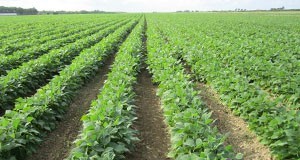Abstract
In terms of acreage, snap beans are the most commonly grown vegetable in Miami-Dade County. This 4-page fact sheet outlines the impact of fertilizer use and local weather and soil on snap bean production in this region. Written by Monica Ozores-Hampton, Qiang Zhu, and Yuncong Li, and published by the UF Department of Horticultural Sciences, May 2015.
HS1261/HS1261: Snap Bean Soil Fertility Program in Miami-Dade County (ufl.edu)
References
Florida Automated Weather Network (FAWN). 2018. "Report Generator." http://fawn.ifas.ufl.edu/data/reports (Accessed March 1, 2018)
Hochmuth, G., D. Maynard, C. Vavrina, E. Hanlon, and E. Simonne. 2015. Plant Tissue Analysis and Interpretation for Vegetable Crops in Florida. HS 964. Gainesville: University of Florida Institute of Food and Agricultural Sciences. https://edis.ifas.ufl.edu/ep081 (Accessed March 1, 2018)
Hochmuth, G., and E. Hanlon. 2016. A Summary of N, P, and K Research with Snap Bean in Florida. SL 331. Gainesville: University of Florida Institute of Food and Agricultural Sciences. https://edis.ifas.ufl.edu/cv234 (Accessed March 1, 2018)
Liu, G., E. H. Simonne, K. T. Morgan, G. J. Hochmuth, M. Ozores-Hampton, and S. Agehara. 2017. Fertilizer Management for Vegetable Production in Florida. CV 296. Gainesville: University of Florida Institute of Food and Agricultural Sciences. https://edis.ifas.ufl.edu/cv296 (Accessed March 1, 2018)
Ozores-Hampton, M. 2012. "Developing a Vegetable Fertility Program Using Organic Amendments and Inorganic Fertilizers." 22: 743-750. https://doi.org/10.21273/HORTTECH.22.6.743
Ozores-Hampton, M., E. J. McAvoy, M. Lamberts, and D. Sui. 2010. "A Survey of the Effectiveness of Current Methods Used for the Freeze Protection of Vegetables in South Florida." 123: 128-133.
Silveira, M. L. 2013. "Soil Acidity and Its Relationship with Nutrient Use Efficiency." Soil and Water Science Program, UF/IFAS Range Cattle Research and Education Center. http://sfbfp.ifas.ufl.edu/articles/article_2013_february.shtml (Accessed March 1, 2018)
Simonne, E., G. Liu, A. Gazula, B. Hochmuth, L. Landrum, D. Gast, L. L. Davis, et al. 2012. "Yield Response of Overhead Irrigated Snap Bean to Nitrogen Rates." . 125: 174-181.
Slaton, N. A., B. R. Golden, R. E. DeLong, and C. G. Massey. 2007. "Green Bean Yield as Affected by Nitrogen Fertilization Strategy." In , edited by N. A. Stalton. Fayetteville, AR: Arkansas Agricultural Experiment Station.
USDA, National Agricultural Statistics Service. 2012 Census of Agriculture-County Data. https://www.agcensus.usda.gov/Publications/2012/Full_Report/Volume_1,_Chapter_2_County_Level/Florida/st12_2_029_029.pdf (Accessed March 1, 2018)
Zhang, S., D. Seal, M. Ozores-Hampton, M. Lamberts, Y. C. Li, W. Klassen, and T. Olczyk. 2017. Snapbean Production in Miami-Dade County, Florida. HS853. Gainesville: University of Florida Institute of Food and Agricultural Sciences. https://edis.ifas.ufl.edu/tr005 (Accessed March 1, 2018)


